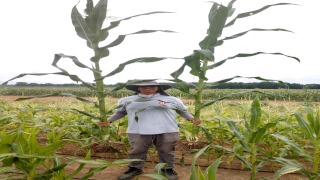By Jeff Mulhollem
A research team led by a Penn State plant scientist has received a $650,000 grant from the U.S. Department of Agriculture’s National Institute of Food and Agriculture to study the functions of key plant genes responsible for regulating the acquisition and use of nitrogen and phosphorus in corn hybrids.
Ruairidh Sawers, assistant professor of plant abiotic stress, and colleagues in Penn State’s College of Agricultural Sciences will collaborate with the research group of Stephen Moose, a crop scientist at the University of Illinois, to learn why some corn varieties are better at acquiring and using nitrogen and phosphorus than others.

Hand-pollinated corn plants in the genetics nursery at Rock Springs maintained by the researchers.
The research is needed because every year, U.S. agriculture applies 15-20 million tons of nitrogen and phosphorus fertilizer to cropland soils, with a combined farm price of more than $10 billion, Sawers noted. A growing population and changing climate are increasing pressure on natural resources while the need for more sustainable food production has become more urgent.
“Recent geopolitical events have placed further strain on fertilizer supply, driving price increases,” he said. “In the U.S., corn cultivation accounts for almost 50% of the total nitrogen and phosphorus fertilizer use, and yet our molecular understanding of how corn plants obtain these nutrients and move them internally to where they are most needed remains limited.”
Through large-scale field evaluation of diverse varieties, the researchers have identified several regions of the corn genome that are associated with superior fertilizer use. This project will further narrow these regions to identify individual genes and the genetic variants that are making the difference.

Doctoral degree student in plant science Sergio Perez Limón harvests corn plants to evaluate root systems and nutrient use.
In previous work, the Sawers lab has focused on phosphate nutrition, while the Moose lab has studied nitrogen use. Interestingly, the work of the two groups has converged on the same candidate genes, providing an “exciting” opportunity for collaboration, Sawers pointed out.
“Plants do not consider these two important nutrients in isolation — and neither should we in our research,” he said. “Efficient use of nitrogen and phosphorus by corn hybrids is a question of balance. Our work will help explain how some corn hybrids are able to find the molecular sweet spot for more efficient nutrient use.”
This research will be made possible through the use of the facilities and support from the staff at Penn State’s Russell E. Larson Agricultural Research Center at Rock Springs, Sawers said.
Source : psu.edu